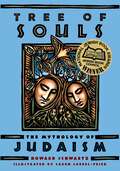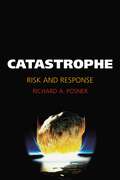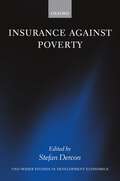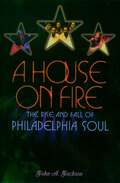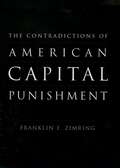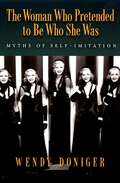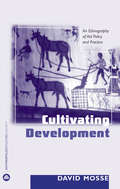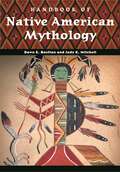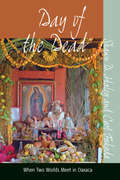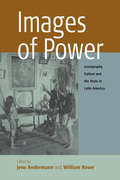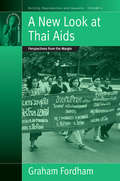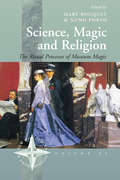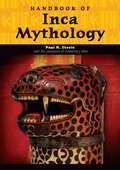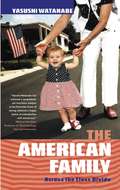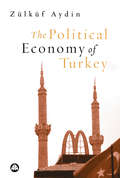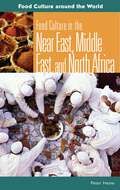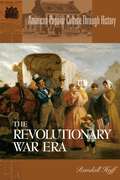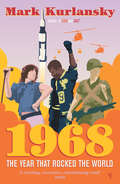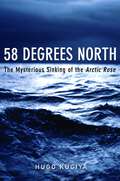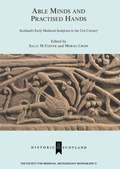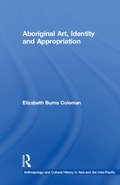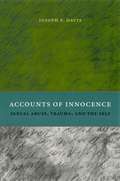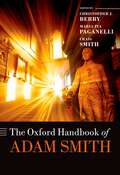- Table View
- List View
Tree of Souls: The Mythology of Judaism
by Howard SchwartzThe first anthology of Jewish mythology in English, Tree of Souls reveals a mythical tradition as rich and as fascinating as any in the world. Drawing from the Bible, the Pseudepigrapha, the Talmud and Midrash, the kabbalistic literature, medieval folklore, Hasidic texts, and oral lore collected in the modern era, Schwartz has gathered together nearly 700 of the key Jewish myths. The myths themselves are marvelous. We read of Adams diamond and the Land of Eretz (where it is always dark), the fall of Lucifer and the quarrel of the sun and the moon, the Treasury of Souls and the Divine Chariot. We discover new tales about the great figures of the Hebrew Bible, from Adam to Moses; stories about God's Bride, the Shekhinah, and the evil temptress, Lilith; plus many tales about angels and demons, spirits and vampires, giant beasts and the Golem. Equally important, Schwartz provides a wealth of additional information. For each myth, he includes extensive commentary, revealing the source of the myth and explaining how it relates to other Jewish myths as well as to world literature (for instance, comparing Eves release of evil into the world with Pandoras). For ease of use, Schwartz divides the volume into ten books, Myths of God, Myths of Creation, Myths of Heaven, Myths of Hell, Myths of the Holy Word, Myths of the Holy Time, Myths of the Holy People, Myths of the Holy Land, Myths of Exile, and Myths of the Messiah.
Catastrophe: Risk and Response
by Richard A. PosnerCatastrophic risks are much greater than is commonly appreciated. Collision with an asteroid, runaway global warming, voraciously replicating nanomachines, a pandemic of gene-spliced smallpox launched by bioterrorists, and a world-ending accident in a high-energy particle accelerator, are among the possible extinction events that are sufficiently likely to warrant careful study. How should we respond to events that, for a variety of psychological and cultural reasons, we find it hard to wrap our minds around? Posner argues that realism about science and scientists, innovative applications of cost-benefit analysis, a scientifically literate legal profession, unprecedented international cooperation, and a pragmatic attitude toward civil liberties are among the keys to coping effectively with the catastrophic risks.
Insurance Against Poverty (Wider Studies In Development Economics)
by Stefan DerconPoor people in developing countries are often affected by droughts, floods, illness, crop failure, job loss, and economic downturns. Much of their energy goes into coping with these shocks and into day-to-day survival. While insurance and credit markets, combined with widespread social security, provide an important cushion against poverty in rich countries, the need for immediate survival may lock the poor into persistent poverty in developing countries. The poor in developing countries do have informal mechanisms to cope with risk and misfortune. These are based on income diversification, risk avoidance, self-insurance by saving together with family, and community-based mutual assistance. Nevertheless, the scope of these mechanisms remains limited. Repeated individual-specific shocks such as illness or pests, or covariate risks associated with drought, flood, or recession, undermine the ability of individuals and their families to cope with risk. We now know much more about vulnerability to risk and how poor people cope. Even more importantly, we have learned much about the large long-term consequences of these risks, which condemns many to persistent poverty and excludes them from economic growth. But there is much that can be done. The micro-level studies that underpin this book offer new insights on how effective public action could be more effective in protecting the vulnerable against persistent poverty. Policy should focus on providing a comprehensive menu of ex-ante and post-crisis protection mechanisms, including new forms of insurance, savings, safety nets, and the means to strengthen the poor's asset base. Local communities have a big role to play: public funds should not be used to replace indigenous community-based support networks; rather they should be used to build on the strengths of these networks to ensure broader and more effective protection. With numerous thematic chapters and case studies of both best practice and of failure, from a mix of low-income and middle-income countries across the developing world, this book evaluates alternatives in widening insurance and protection provision, and makes an important contribution to the topical field of insurance and risk.
A House on Fire: The Rise and Fall of Philadelphia Soul
by John A. Jackson"If You Don't Know Me By Now," "The Love I Lost," "The Soul Train Theme," "Then Came You," "Ain't No Stoppin' Us Now"--the distinctive music that became known as Philly Soul dominated the pop music charts in the 1970s. In A House on Fire, John A. Jackson takes us inside the musical empire created by Kenny Gamble, Leon Huff, and Thom Bell, the three men who put Philadelphia Soul on the map. Here is the eye-opening story of three of the most influential and successful music producers of the seventies. Jackson shows how Gamble, Huff, and Bell developed a black recording empire second only to Berry Gordy's Motown, pumping out a string of chart-toppers from Harold Melvin & the Blue Notes, the Spinners, the O'Jays, the Stylistics, and many others. The author underscores the endemic racism of the music business at that time, revealing how the three men were blocked from the major record companies and outlets in Philadelphia because they were black, forcing them to create their own label, sign their own artists, and create their own sound. The sound they created--a sophisticated and glossy form of rhythm and blues, characterized by crisp, melodious harmonies backed by lush, string-laden orchestration and a hard-driving rhythm section--was a glorious success, producing at least twenty-eight gold or platinum albums and thirty-one gold or platinum singles. But after their meteoric rise and years of unstoppable success, their production company finally failed, brought down by payola, competition, a tough economy, and changing popular tastes. Funky, groovy, soulful--Philly Soul was the classic seventies sound. A House on Fire tells the inside story of this remarkable musical phenomenon.
The Contradictions of American Capital Punishment (Studies in Crime and Public Policy)
by Franklin E. ZimringWhy does the United States continue to employ the death penalty when fifty other developed democracies have abolished it? Why does capital punishment become more problematic each year? How can the death penalty conflict be resolved? In The Contradictions of American Capital Punishment, Frank Zimring reveals that the seemingly insoluble turmoil surrounding the death penalty reflects a deep and long-standing division in American values, a division that he predicts will soon bring about the end of capital punishment in our country. On the one hand, execution would seem to violate our nation's highest legal principles of fairness and due process. It sets us increasingly apart from our allies and indeed is regarded by European nations as a barbaric and particularly egregious form of American exceptionalism. On the other hand, the death penalty represents a deeply held American belief in violent social justice that sees the hangman as an agent of local control and safeguard of community values. Zimring uncovers the most troubling symptom of this attraction to vigilante justice in the lynch mob. He shows that the great majority of executions in recent decades have occurred in precisely those Southern states where lynchings were most common a hundred years ago. It is this legacy, Zimring suggests, that constitutes both the distinctive appeal of the death penalty in the United States and one of the most compelling reasons for abolishing it. Impeccably researched and engagingly written, Contradictions in American Capital Punishment casts a clear new light on America's long and troubled embrace of the death penalty.
The Woman Who Pretended to Be Who She Was: Myths of Self-Imitation
by Wendy DonigerMany cultures have myths about self-imitation, stories about people who pretend to be someone else pretending to be them, in effect masquerading as themselves. This great theme, in literature and in life, tells us that people put on masks to discover who they really are under the masks they usually wear, so that the mask reveals rather than conceals the self beneath the self. In this book, noted scholar of Hinduism and mythology Wendy Doniger offers a cross-cultural exploration of the theme of self-impersonation, whose widespread occurrence argues for both its literary power and its human value. The stories she considers range from ancient Indian literature through medieval European courtly literature and Shakespeare to Hollywood and Bollywood. They illuminate a basic human way of negotiating reality, illusion, identity, and authenticity, not to mention memory, amnesia, and the process of aging. Many of them involve marriage and adultery, for tales of sexual betrayal cut to the heart of the crisis of identity. These stories are extreme examples of what we common folk do, unconsciously, every day. Few of us actually put on masks that replicate our faces, but it is not uncommon for us to become travesties of ourselves, particularly as we age and change. We often slip carelessly across the permeable boundary between the un-self-conscious self-indulgence of our most idiosyncratic mannerisms and the conscious attempt to give the people who know us, personally or publicly, the version of ourselves that they expect. Myths of self-imitation open up for us the possibility of multiple selves and the infinite regress of self-discovery. Drawing on a dizzying array of tales-some fact, some fiction-The Woman Who Pretended to Be Who She Was is a fascinating and learned trip through centuries of culture, guided by a scholar of incomparable wit and erudition.
Cultivating Development: An Ethnography of Aid Policy and Practice (Anthropology, Culture and Society)
by David MosseWhat if development agencies and researchers are not driven by policy? Suppose that the things that make for 'good policy' - policy that legitimises and mobilises political support - in reality make it impossible to implement?*BR**BR*By focusing in detail on the unfolding activities of a development project in western India over more than ten years, as it falls under different policy regimes, this book takes a close look at the relationship between policy and practice in development. David Mosse shows how the actions of development workers are shaped by the exigencies of organisations and the need to maintain relationships rather than by policy; but also that development actors work hardest of all to maintain coherent representations of their actions as instances of authorised policy. Raising unfamiliar questions, Mosse provides a rare self-critical reflection on practice, while refusing to endorse current post-modern dismissal of development.
Handbook of Native American Mythology (World Mythology)
by Dawn Bastian Williams Judy K. MitchellPopular Hopi kachina dolls and awesome totem poles are but two of the aspects of the sophisticated, seldom-examined network of mythologies explored in this fascinating volume.This revealing work introduces readers to the mythologies of Native Americans from the United States to the Arctic Circle—a rich, complex, and diverse body of lore, which remains less widely known than mythologies of other peoples and places.In thematic chapters and encyclopedia-style entries, Handbook of Native American Mythology examines the characters and deities, rituals, sacred locations and objects, concepts, and stories that define and distinguish mythological cultures of various indigenous peoples. By tracing the traditions as far back as possible and following their evolution from generation to generation, Handbook of Native American Mythology offers a unique perspective on Native American history, culture, and values. It also shows how central these traditions are to contemporary Native American life, including the continuing struggle for land rights, economic parity, and repatriation of cultural property.
Day of the Dead: When Two Worlds Meet in Oaxaca
by Shawn D. Haley Curt FukudaThe Day of the Dead is the most important annual celebration in Oaxaca, Mexico. Skillfully combining textual information and photographic imagery, this book begins with a discussion of the people of Oaxaca, their way of life, and their way of looking at the world. It then takes the reader through the celebration from the preparations that can begin months in advance through to the private gatherings in homes and finally to the cemetery where the villagers celebrate together — both the living and the dead. The voices in the book are of those people who have participated in the Day of the Dead for as long as they can remember. There are no ghosts here. Only the souls of loved ones who have gone to the Village of the Dead and who are allowed to return once a year to be with their family. Very readable and beautifully illustrated, this book provides an extensive discussion of the people of Oaxaca, their way of life and their beliefs, which make the Day of the Dead logical and easily comprehensible.
Images of Power: Iconography, Culture and the State in Latin America (Remapping Cultural History #2)
by Jens Andermann William RoweIn Latin America, where even today writing has remained a restricted form of expression, the task of generating consent and imposing the emergent nation-state as the exclusive form of the political, was largely conferred to the image. Furthermore, at the moment of its historical demise, the new, 'postmodern' forms of sovereignty appear to rely even more heavily on visual discourses of power. However, a critique of the iconography of the modern state-form has been missing. This volume is the first concerted attempt by cultural, historical and visual scholars to address the political dimension of visual culture in Latin America, in a comparative perspective spanning various regions and historical stages. The case studies are divided into four sections, analysing the formation of a public sphere, the visual politics of avant-garde art, the impact of mass society on political iconography, and the consolidation and crisis of territory as a key icon of the state.
A New Look At Thai Aids: Perspectives from the Margin (Fertility, Reproduction and Sexuality: Social and Cultural Perspectives #4)
by Graham FordhamFollowing the detection of the first HIV infections in the early 1980s, by the 1990s Thailand was routinely depicted as having the world’s fastest moving HIV/AIDS epidemic. However, by the early 2000’s the bulk of scholarly and medical AIDS literature portrayed the epidemic as being largely under control, and claimed that Thai AIDS prevention efforts during the 1990s had been successful. Based on long-term ethnographic research conducted in Northern Thailand this book makes an in-depth study of the social construction of Thailand’s HIV/AIDS epidemic over this period. In addition to his own field research the author draws on an extensive corpus of English and Thai language social science and medical HIV/AIDS literature to examine the modeling of Thailand’s AIDS epidemic, and addresses concepts and issues such as risk groups, risk behaviour, alcohol use, gender and class, masculinity, the scapegoating of female prostitutes and men in the underclass, the reporting of the HIV/AIDS epidemic in Thailand’s indigenous Thai language media, and sexual activity amongst Thai youth. The analysis demonstrates the contribution of anthropology as an interpretative social science, and the use of anthropological theory and research methods, to finding alternative ways of framing the problems of Thai AIDS and of posing new questions that will lead to more effective points of intervention. It emphasises the necessity for critically reflexive approaches that question the ‘taken for granted’ and demonstrates how qualitative research techniques guided by social theory have the potential to take account of local meanings in complex social contexts where traditional values and cultural practices are rapidly transforming due to economic and social change. The book offers a sustained and powerful criticism of the limitations of the normative model of the Thai AIDS epidemic and, in its aim of promoting critically reflexive AIDS research techniques in order to produce a better understanding of issues ‘on the ground’ and hence better health policy and more effective AIDS interventions, speaks not only to the Thai AIDS epidemic but to AIDS epidemics throughout Southeast Asia and elsewhere. This is the only English language study of Thailand’s HIV/AIDS epidemic to draw on long-term qualitative research in Northern Thailand as well as on a broad range of Thai (and some Khmer language) materials. Its contextualised and subtly nuanced analysis of the AIDS epidemic and of the impact of AIDS control initiatives, in concert with the theoretical and methodological contributions it makes to AIDS research and policy and behavioural interventions, makes it a timely publication of vital interest to scholars in the social sciences, as well as to the members of non-governmental organisations and international organisations working in the HIV/AIDS, health and development fields.
Science, Magic and Religion: The Ritual Processes of Museum Magic (New Directions in Anthropology #23)
by Mary Bouquet Nuno PortoFor some time now, museums have been recognized as important institutions of western cultural and social life. The idea of the museum as a ritual site is fairly new and has been applied to the art museums in Europe and the United States so far. This volume expands it by exploring a range of contemporary museums in Europe and Africa. The case studies examine the different ways in which various actors involved in cultural production dramatize and ritualize such sites. It turns out that not only museum specialists, but visitors themselves are engaged in complex performances and experiences that make use of museums in often unexpected ways.
Handbook of Inca Mythology (World Mythology)
by Paul Richard SteeleThe first introduction to the Incas and their myths aimed at students and general readers, bringing together a wealth of information into one convenient resource.Full of hard to find information, Handbook of Inca Mythology provides an accessible introduction to the rites, beliefs, and spiritual tales of the Incas. It provides a concise overview of Incan civilization and mythology, a chronology of mythic and historical events, and an A–Z inventory of central themes (sacrifice, fertility, competition, reversaldualism, colors, constellations, giants, and miniatures), personages (Viracocha, Manco Capac, Pachackuti Inca), locations (Lake Titicaca, Corickancha), rituals, and icons.The last Native American culture to develop free of European influence, the Incas, who had no written language, are known only from Spanish accounts written after the conquest and archaeological finds. From these fragments, a vanished world has been reborn and reintroduced into modern Andean life. There is no better way into that world and its mind-bending mythology than this unique handbook.
The American Family: Across the Class Divide
by Yasushi WatanabeWhite, middle-class Americans are one of the most understudied groups in the anthropology of the United States – perhaps because of their hegemonic presence in society. This book offers the first ethnography of 'white middle-class America' from a non-native perspective. *BR**BR*Yasushi Watanabe, a Japanese anthropologist, examines two social groups in the Boston area to reveal an intimate portrait of the 'American' family. These two groups are at opposite ends of the social spectrum in terms of religious, ethnic and class backgrounds, and in terms of cultural tastes and lifestyles. The first group is upper-middle class, Anglo Saxon, Protestant, mostly Unitarian or Episcopalian - often identified as archetypical middle-class America. This is a wealthy group that includes descendants of the 'Boston Brahmins', one of America's oldest aristocratic families, closely related to Democratic hopeful John Kerry. The second group is working-class or lower middle-class, Irish Catholic, often referred to as 'Boston Irish'. *BR**BR*Informed by a wide range of social theory, The American Family is a fascinating study of family dynamics in modern America that explores how Americans construct their social realities and cultural histories, and how modern society shapes their lived experience.
The Political Economy of Turkey (Third World in Global Politics)
by Zülküf AydinSince the 1970s, Turkey has faced some of the most serious crises since the Republic was established in 1923. This book analyses the political and socio-economic problems faced by Turkey in recent decades and the country's gradual integration into the global economy. *BR**BR*Social unrest, political and ethnic violence, paralysis of the state bureaucracy and other institutions, increasing foreign debt, decreasing economic growth, vast inflation and increasing unemployment have all been part of everyday life in Turkey's recent history. Zulkuf Aydin argues that this state of affairs is symptomatic of a deeper, more enduring crisis arising from the way in which Turkey has been integrated into the global economy. Looking at democracy, repression, the military, the Kurdish question and regional inequalities, civil society, human rights and Islamic fundamentalism in Turkey, he shows how Turkey has become reliant on foreign investment and international financial institutions, offering a broader critique of globalisation in this light.
Food Culture in the Near East, Middle East, and North Africa (Food Culture around the World)
by Peter HeineThe similar cuisines of the Near East, Middle East, and North Africa stem from ancient cultures and variable climates, ranging from Mediterranean to desert. The major monotheistic religions developed in the Middle East, and students and other readers will learn how religious strictures on food and drink continue to play an important role in eating habits there today for Muslims, Jews, and Christians. Most of the population in the regions is Arab, and therefore the emphasis in this volume is mainly on the Arab Muslim food cultures. The impact of colonialism, globalization, and modernization of the foodways is also discussed in the topical chapters.This thorough overview provides huge insight into the lives of everyday people in the regions through their food culture. One chapter describes the major foodstuffs and how they are used. Another discusses gender roles and cooking, the use of cookbooks, and details the typical kitchen and its contents, from appliances to utensils. A chapter on typical meals shows the daily rituals of the various peoples. The Eating Out chapter provides a fascinating look at the workings and décor of small, traditional restaurants, the popularity of picnics, and more. Next, food in the context of religious holidays and life-cycle celebrations is discussed. Finally, traditional folk and modern beliefs about diet and health round out the coverage.
The Revolutionary War Era (American Popular Culture Through History)
by Randall HuffThis volume in Greenwood's American Popular Culture through History series recreates the many ways in which a new American culture took root during the Revolutionary period. Tavern culture and pamphlet literature played integral parts in debates surrounding the Revolution. Newspapers spread information while printing the first advertisements. Courtship and marriage rituals varied greatly among the rich and poor, and among city and country folk. Public performance art was a hotly debated component of the increased schism between secular and religious concerns, though many Americans enjoyed recreations of recent military battles. Foodways were distinctly regional, yet food rationing was a universal hardship among army personnel. Randall Huff's narrative essays, as well as many extra front- and back-matter resources, help describe citizen's lives in the newly formed United States of America as the nation fought to win its independence.American Popular Culture through History is the only reference series that presents a detailed, narrative discussion of United States popular culture. This volume is one of 17 in the series, each of which presents essays on Everyday America, The World of Youth, Advertising, Architecture, Fashion, Food, Leisure Activities, Literature, Music, Performing Arts, Travel, and Visual Arts.
1968: The Year that Rocked the World
by Mark KurlanskyIt was the year of sex and drugs and rock and roll; it was also the year of the Martin Luther King and Bobby Kennedy assassinations, the Prague Spring, the Chicago convention, the Tet offensive in Vietnam and the anti-war movement, the student rebellion that paralysed France, civil rights, the beginning of the end for the Soviet Union, and the birth of the women's movement. With 1968: The Year that Rocked the World, award-winning journalist Mark Kurlansky has written his Magnum opus - a cultural and political history of that world-changing year of social upheaval, when television's impact on global events first became apparent, and when simultaneously - in Paris, Prague, London, Berkeley, and all over the globe - uprisings spontaneously occurred. 1968 encompasses the worlds of youth and music, politics, war, economics, assassinations, riots, demonstrations and the media, and shows us how we got to where we are today.
58 Degrees North: The Mysterious Sinking of the Arctic Rose
by Hugo KugiyaIn the spring of 2001, an industrial fishing trawler went down in the icy waters just below the Arctic Circle, with its position last recorded at 58 degrees north. The Arctic Rose sank so abruptly that there was not even time to put on survival suits or call for help, and all fifteen men aboard were killed. Hugo Kugiya's book is a powerful story of adventure and disaster, illuminating how the modern industrial fishing industry gave rise to these fifteen young men's dangerous and strangely archaic life, and tracing the Coast Guard investigation into what really sank the Arctic Rose. Hugo Kugiya has worked as a journalist for fifteen years, reporting for the Orlando Sentinel, the Seattle Times, and Newsday, among others. His 2001 series on the sinking of the Arctic Rose won Newsday's Publisher's Award. He lives in Seattle with his daughter. This is his first book. "Highly readable... the portraits of the doomed fishermen-Capt. Dave Randall, Mexican immigrant Angel Mendez (seen mostly through the eyes of his widow), amiable drifter Eddie Haynes-grip and fascinate...Bound to suck in maritime buffs."-Publishers Weekly "Kugiya ably reconstructs events and characters...a crew fit for a World War II film, all facing a cruel sea."-Hollywood Reporter "Sympathetic to the difficulties that fishermen face but not sentimental, Kugiya puts a human face on an assortment of drifters, illegal aliens, and small businessmen, all hard-working men who turned to the sea for escape or a means to a new start. An intriguing look into one of the most dangerous occupations in America."-Library Journal
Able Minds and Practiced Hands: Scotland's Early Medieval Sculpture in the 21st Century (The Society for Medieval Archaeology Monographs #Vol. 23)
by SallyM. FosterOne hundred years on from J Romilly Allen and Joseph Anderson's 1903 landmark publication, The Early Christian Monuments of Scotland, twenty six essays explore the current state of knowledge of early medieval sculpture in Scotland. They demonstrate the unique value of this material in contributing to our understanding of the society and people that created it between 1000 to 1500 years ago. Today's approaches and techniques offer new insights, as well as great hope, for what might be learnt from future study of 'familiar' and new material alike. The essays exemplify the ever-diversifying, interdisciplinary approaches that are being taken to the study of early medieval sculpture. Key themes that emerge include: the interdependence of conservation, research and access; the need for a 21st-century inventory of the sculpture; the breadth and value of the wide range of the research tools that now exist; conservation issues, including the politics of how and where sculpture should be protected, and the pressing need to identify priorities for action; and, what is probably the most important development over the last 100 years, the increase in awareness of the range of values and significances that attaches to early medieval sculpture, including appreciation of context.
Able Minds and Practiced Hands: Scotland's Early Medieval Sculpture in the 21st Century (The Society for Medieval Archaeology Monographs)
by SallyM. FosterOne hundred years on from J Romilly Allen and Joseph Anderson's 1903 landmark publication, The Early Christian Monuments of Scotland, twenty six essays explore the current state of knowledge of early medieval sculpture in Scotland. They demonstrate the unique value of this material in contributing to our understanding of the society and people that created it between 1000 to 1500 years ago. Today's approaches and techniques offer new insights, as well as great hope, for what might be learnt from future study of 'familiar' and new material alike. The essays exemplify the ever-diversifying, interdisciplinary approaches that are being taken to the study of early medieval sculpture. Key themes that emerge include: the interdependence of conservation, research and access; the need for a 21st-century inventory of the sculpture; the breadth and value of the wide range of the research tools that now exist; conservation issues, including the politics of how and where sculpture should be protected, and the pressing need to identify priorities for action; and, what is probably the most important development over the last 100 years, the increase in awareness of the range of values and significances that attaches to early medieval sculpture, including appreciation of context.
Aboriginal Art, Identity and Appropriation (Anthropology and Cultural History in Asia and the Indo-Pacific)
by Elizabeth Burns ColemanThe belief held by Aboriginal people that their art is ultimately related to their identity, and to the continued existence of their culture, has made the protection of indigenous peoples' art a pressing matter in many postcolonial countries. The issue has prompted calls for stronger copyright legislation to protect Aboriginal art. Although this claim is not particular to Australian Aboriginal people, the Australian experience clearly illustrates this debate. In this work, Elizabeth Burns Coleman analyses art from an Australian Aboriginal community to interpret Aboriginal claims about the relationship between their art, identity and culture, and how the art should be protected in law. Through her study of Yolngu art, Coleman finds Aboriginal claims to be substantially true. This is an issue equally relevant to North American debates about the appropriation of indigenous art, and the book additionally engages with this literature.
Aboriginal Art, Identity and Appropriation (Anthropology and Cultural History in Asia and the Indo-Pacific)
by Elizabeth Burns ColemanThe belief held by Aboriginal people that their art is ultimately related to their identity, and to the continued existence of their culture, has made the protection of indigenous peoples' art a pressing matter in many postcolonial countries. The issue has prompted calls for stronger copyright legislation to protect Aboriginal art. Although this claim is not particular to Australian Aboriginal people, the Australian experience clearly illustrates this debate. In this work, Elizabeth Burns Coleman analyses art from an Australian Aboriginal community to interpret Aboriginal claims about the relationship between their art, identity and culture, and how the art should be protected in law. Through her study of Yolngu art, Coleman finds Aboriginal claims to be substantially true. This is an issue equally relevant to North American debates about the appropriation of indigenous art, and the book additionally engages with this literature.
Accounts Of Innocence (PDF): Sexual Abuse, Trauma, And The Self
by Joseph E. DavisSince a new sensitivity and orientation to victims of injustice arose in the 1960s, categories of victimization have proliferated. Large numbers of people are now characterized and characterize themselves as sufferers of psychological injury caused by the actions of others. In contrast with the familiar critiques of victim culture, Accounts of Innocence offers a new and empirically rich perspective on the question of why we now place such psychological significance on victimization in people's lives.
Adam Smith: The Invisible Hand And Spontaneous Order (Routledge Studies In Social And Political Thought Ser.)
by Craig Smith Christopher J. Berry Maria Pia PaganelliAdam Smith (1723-90) is a thinker with a distinctive perspective on human behaviour and social institutions. He is best known as the author of the An Inquiry into the Nature and Causes of the Wealth of Nations (1776). Yet his work is name-checked more often than it is read and then typically it is of an uninformed nature; that he is an apologist for capitalism, a forceful promoter of self-interest, a defender of greed and a critic of any 'interference' in market transactions . To offset this caricature, this Handbook provides an informed portrait. Drawing on the expertise of leading Smith scholars from around the world, it reflects the depth and breadth of Smith's intellectual interests. After an introductory outline chapter on Smith's life and times, the volume comprises 28 new essays divided into seven parts. Five sections are devoted to particular themes in Smith's corpus - his views on Language, Art and Culture; his Moral Philosophy; his Economic thought, his discussions of History and Politics and his analyses of Social Relations. These five parts are framed by one that focuses on the immediate and proximate sources of his thought and the final one that recognizes Smith's status as a thinker of world-historical significance - indicating both his posthumous impact and influence and his contemporary resonance. While each chapter is a discrete contribution to scholarship, the Handbook comprises a composite whole to enable the full range of Smith's work to be appreciated.
